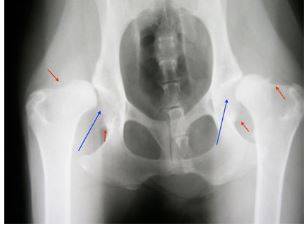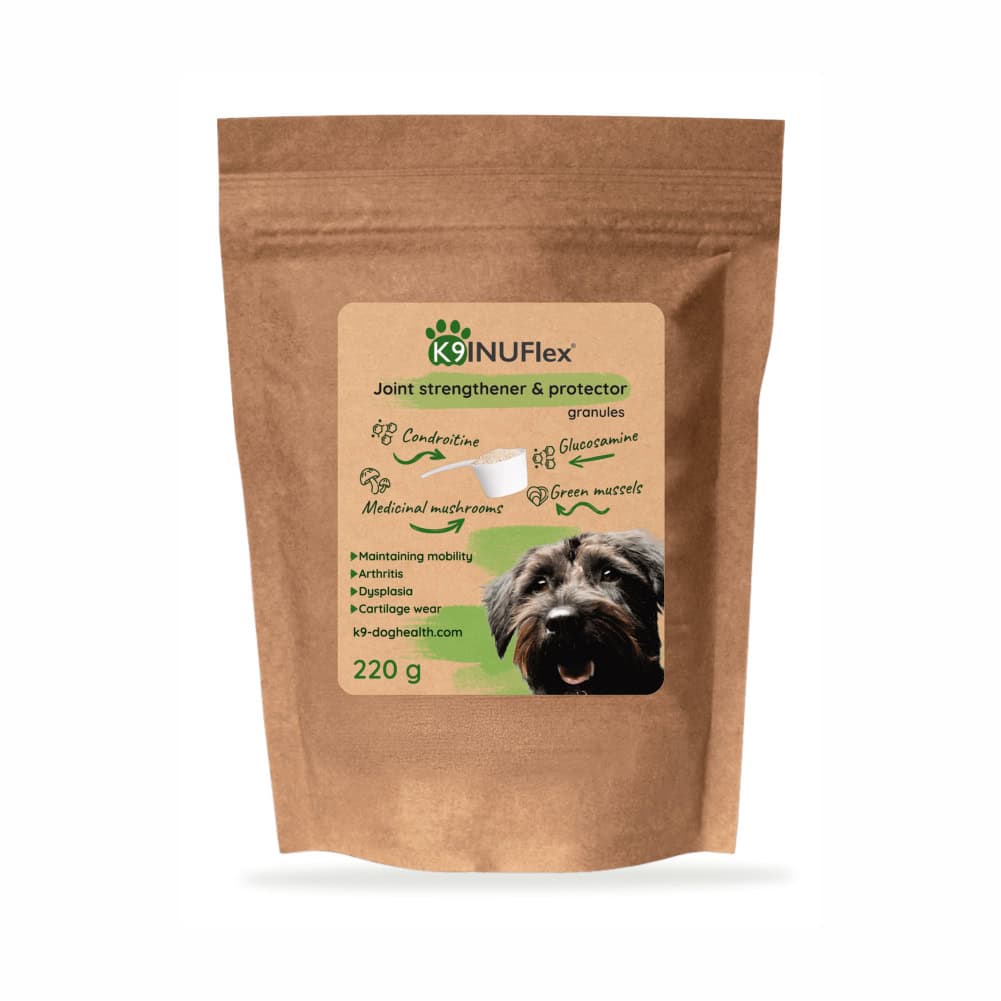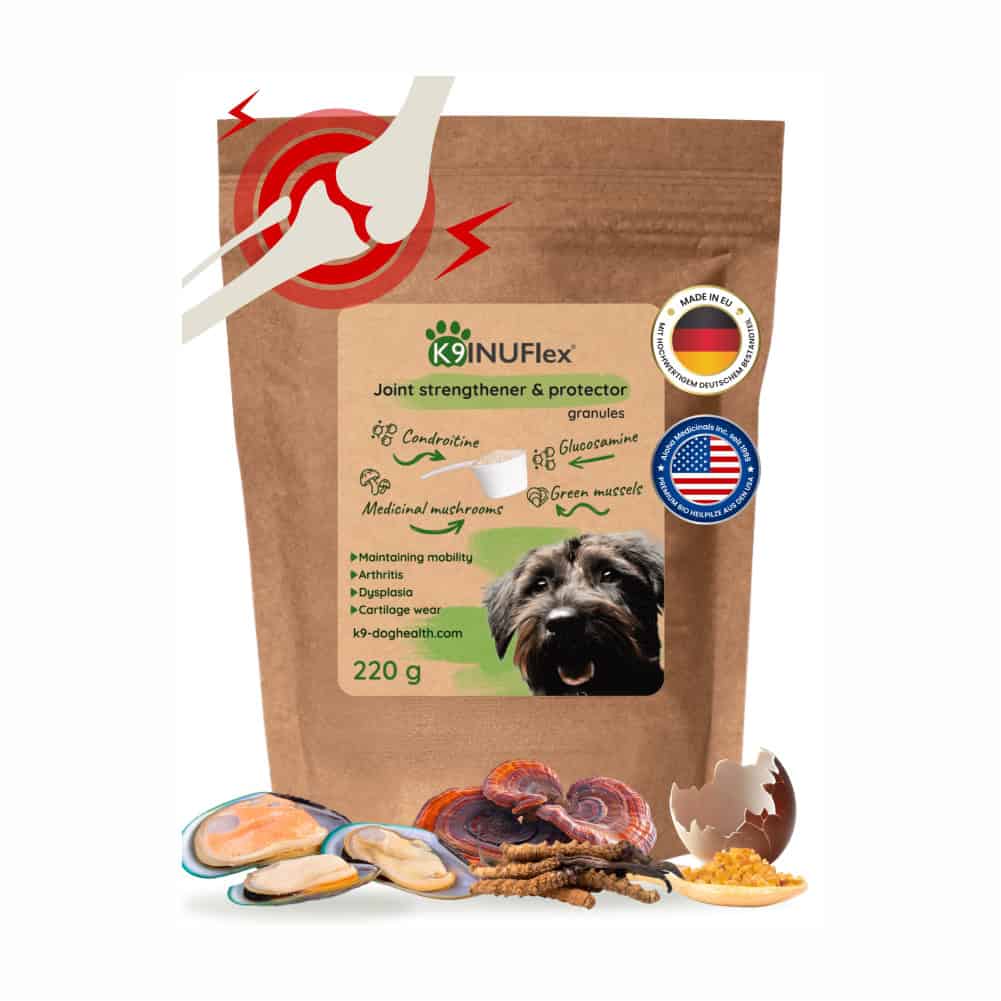Canine hip dysplasia – What every dog owner should know
Canine hip dysplasia is a hereditary musculoskeletal disorder in dogs, where the head of the femur does not fit properly into the socket of the pelvis, because the joint does not develop as it should. This misalignment can lead to partial or complete dislocation, and over time it results in cartilage wear, inflammation, and severe arthritis, so without proper management the condition can worsen quickly. Although the condition is genetic, environmental factors – such as overfeeding, overexertion, or improper exercise – can significantly increase the risk of its development.
Description of canine hip dysplasia
The essence of the disease is that in a poorly fitting joint, the femoral head constantly slips out of the socket. This abnormal movement over time causes cartilage wear, inflammation, cartilage degeneration, bone deposits, and eventually hip osteoarthritis. Even partial dislocation and inflammation may cause mobility issues, but cartilage damage leads to the most severe problems.
Forms of dysplasia

- Hip dysplasia (HD) – (this is the most common and often simply referred to as dysplasia),
- Elbow dysplasia (ED) – (its significance is steadily increasing),
- Shoulder dysplasia – (currently less well known).
Symptoms of canine hip dysplasia
- Pain and stiffness after exercise – the dog struggles to start moving after rest, and it often needs to “warm up.”
- Limping or difficulty walking, which worsens under load, so owners may notice it after play or longer walks.
- Stiffness of the hind legs, because the range of motion becomes reduced over time.
- Avoidance of stairs and jumping, and this reluctance usually indicates discomfort or pain.
- Bunny-hopping movement while running or walking, but not during slow-paced walking.
- Gradual muscle atrophy of the hind limbs, so the legs may look thinner and weaker.
- Behavioral changes – irritability, withdrawal, or loss of appetite due to pain, and these signs often confuse owners at first.
- Difficulty rising from a lying position, because the dog feels pain in its hips and often requires assistance.
Diagnostics and examination methods
Accurate diagnosis requires a combination of several examination methods:
- X-ray – the main tool for detecting misalignments and arthritis of the hip joint, but sedation is usually required for official screening.
- CT and MRI – provide more detailed images of cartilage, bone, and soft tissue, mainly in complex cases.
- Ortolani and Barlow tests – specific orthopedic maneuvers to evaluate hip joint stability.
- Official screening tests – independent veterinary evaluations that also determine breeding suitability.
Prognosis and life expectancy
The prognosis of canine hip dysplasia depends on the severity of the condition, the age of the dog, and the chosen treatment, because all of these factors play a crucial role:
- Mild cases – with proper lifestyle (weight management, exercise plan, and supplements) dogs can live full lives, and they often remain active for many years.
- Moderate dysplasia – symptoms can often be managed with medication, physiotherapy, and supportive therapies, so the progression of the disease can be slowed down.
- Severe dysplasia – without surgery, significant mobility limitations are common, but surgical intervention (e.g. total hip replacement) can allow dogs to live active and pain-free lives again.
Treatment options for canine hip dysplasia
Treatment varies depending on the degree of the condition:
Conservative therapy
- Weight control
- Moderate, low-impact exercise program
- Anti-inflammatory and pain-relieving medication
- Physiotherapy and hydrotherapy
- Joint supplements
Surgical solutions for canine hip dysplasia
- TPO (Triple pelvic osteotomy) – pelvic reconstruction surgery for young dogs to improve joint fit.
- FHO (Femoral head ostectomy) – removal of the femoral head, allowing a pain-free “false joint” to form.
- Total hip replacement – used in the most severe cases, offering excellent long-term quality of life.
- Alternative methods – such as gold bead implantation (GBI) as complementary therapy.
Alternative and complementary therapies
- Laser therapy
- Acupuncture
- Stem cell and PRP treatment
Natural support for canine dysplasia
Alongside medication and veterinary treatment, more and more natural compounds prove to be useful as complementary support. They cannot cure dysplasia, but they may help relieve symptoms, reduce inflammation, and improve joint function.
- Omega-3 fatty acids (EPA, DHA): their anti-inflammatory effects may improve mobility. (K9 INUKrill®)
- Green-lipped mussel extract: a natural source of glucosamine and chondroitin, supporting cartilage elasticity.
- Eggshell membrane (ESM): with its complex mix of collagen, glucosamine, chondroitin, and hyaluronic acid, it may support joint flexibility and help reduce inflammation.
- Collagen peptides: may contribute to cartilage and connective tissue regeneration.
- Curcumin: a strong antioxidant and natural anti-inflammatory.
- Boswellia serrata: may ease joint pain and reduce inflammation.
- Hyaluronic acid: improves the lubricating capacity of joint fluid.
- Vitamins (C and E): act as antioxidants, protecting cartilage from damage.
These natural supplements cannot replace medical treatment, but they may help slow the progression of dysplasia and improve your dog’s quality of life.
The role of nutrition
Hip dysplasia in dogs is not only influenced by genetics but also heavily by diet. High-energy diets that promote rapid growth increase joint stress, while obesity worsens existing issues. Therefore, with a proper diet and targeted supplements, you can significantly improve your dog’s condition.
- Balanced calcium-phosphorus ratio: essential for healthy bone development and joint stability, and it supports proper joint alignment.
- Optimal protein and energy content: avoid excessive calorie intake, but feed smaller portions more often so digestion and growth remain balanced.
- Supplements: K9 FullFlex™ helps protect cartilage, while K9 INUKrill® provides valuable omega-3 fatty acids to reduce inflammation.
Genetic background and breeding responsibility
Since canine hip dysplasia is hereditary, responsible breeding plays a crucial role. Screening tests and excluding affected dogs from breeding are essential for the health of future generations.
Prevention and puppy care
Although hip dysplasia is inherited, environmental factors strongly influence its development. Prevention during puppyhood is especially important:
- Avoid overfeeding and growth-promoting diets.
- Provide non-slip surfaces at home to prevent hip injuries.
- Balanced exercise – avoid overexertion, but lack of activity is also harmful.
- Regular screenings at a young age, especially for predisposed breeds.
Since canine hip dysplasia raises many practical questions for owners, you will find a detailed and easy-to-read FAQ section below. This part provides quick answers to the most common questions so you can immediately access the information you need.
Frequently asked questions about canine hip dysplasia
❓ At what age do symptoms usually appear?
The first signs typically appear between 5–12 months of age (e.g. unsteady gait, bunny-hopping movement, avoiding stairs). However, mild cases may only become visible later, in adulthood or old age, when arthritis symptoms dominate.
❓ Is canine hip dysplasia hereditary?
Yes. It is inherited with a threshold value: genetic predisposition may be present without symptoms, but environmental factors (overfeeding, rapid growth, overexertion) can push it over the “threshold,” leading to disease. This is why breeding screening and responsible pairing are essential.
❓ Can it be treated without surgery?
In mild and moderate cases, often yes. Weight control, gentle exercise, physiotherapy and hydrotherapy, pain and anti-inflammatory treatment, as well as joint and omega-3 supplements can significantly improve quality of life and slow progression.
❓ Which sports or activities should be avoided?
Avoid sudden, high-impact activities (jumping, intense fetch, stair climbing, slippery floors). Choose controlled exercises: steady-paced walks, swimming, targeted physiotherapy, and muscle-strengthening on soft ground.
❓ Should joint supplements be given even if the dog is symptom-free?
Yes, in predisposed breeds or in early mild cases, preventive supplementation can help. Glucosamine, chondroitin, collagen, and hyaluronic acid, along with omega-3 fatty acids (such as krill oil), support cartilage metabolism and may reduce inflammation.
❓ Can natural supplements help?
Yes. Green-lipped mussel (glucosamine, chondroitin), boswellia (natural anti-inflammatory), eggshell membrane (collagen, elastin, hyaluronic acid), and colostrum (immune-modulating effects) are often part of complex conservative therapy. They do not replace veterinary care but provide effective support.
Canine hip dysplasia – Summary and advice
When detected early, canine hip dysplasia can be effectively managed, and timely care greatly improves outcomes. Proper nutrition, regular screenings, physiotherapy, and dietary supplements all work together, so they help ensure your dog lives a long and pain-free life.
If you want to learn more about mobility and joint health in dogs, check out our Dog Diseases: Joint & Mobility section, where you will find more articles on arthritis, elbow dysplasia, and other joint problems in dogs.
Recommended reading
The world of dogs is full of fascinating facts and important knowledge. Many owners first face serious decisions when choosing a puppy from the litter – how to select the one that fits the family and lifestyle. During training, dog tricks not only entertain but also strengthen the bond between dog and owner.
Of course, it is not always just fun and games: every responsible owner should be aware of the problems caused by anal gland inflammation, or how to recognize and prevent infectious kennel cough. Equally important is understanding canine body language – for example, what tail wagging reveals about happiness or uncertainty.
Movement and shared activities are also essential: frisbee is a great way for dogs to release energy while improving agility and strengthening muscles. Yet movement is only enjoyable when there is no pain – which is why every owner must know how arthritis in dogs develops and what can be done for prevention and treatment.
Important: This article on canine hip dysplasia is for informational purposes only and does not replace veterinary examination or treatment. For accurate diagnosis and appropriate therapy, always consult your veterinarian.
References:
- Gencoglu, H., Orhan, C., Sahin, E., & Sahin, K. (2020). Undenatured Type II Collagen (UC-II) in Joint Health and Disease: A Review on the Current Knowledge of Companion Animals. Animals, 10(4), 697.
- Zapata, A., & Fernández-Parra, R. (2023). Management of Osteoarthritis and Joint Support Using Feed Supplements: A Scoping Review of Undenatured Type II Collagen and Boswellia serrata. Animals, 13(5), 870.
- Eginton, K. A., et al. (2024). Lifetime cost of surgical treatment for canine hip osteoarthritis: multimodal conservative management vs. FHNE vs. total hip replacement. Journal of the American Veterinary Medical Association, 262(8).
- Kealy, R. D., Lawler, D. F., Monti, K. L., Biery, D. N., Helms, R. W., Lust, G., & Smith, G. K. (1992). Effects of limited food consumption on the incidence of hip dysplasia in growing dogs. Journal of the American Veterinary Medical Association, 201(6), 857–863.
- Fritsch, D. A., Allen, T. A., Dodd, C. E., Jewell, D. E., Sixby, K. A., Leventhal, P. S., & Brejda, J. (2010). A multicenter study of the effect of dietary supplementation with fish oil omega-3 fatty acids on carprofen dosage in dogs with osteoarthritis. Journal of the American Veterinary Medical Association, 236(5), 535–539.
- Rialland, P., Bichot, S., Lussier, B., Moreau, M., Beaudry, F., del Castillo, J. R. E., & Gauvin, D. (2013). Effect of a diet enriched with green-lipped mussel on pain behavior and mobility in dogs with clinical osteoarthritis. Research in Veterinary Science, 94(3), 753–760.
- Kampa, N., Duangnumsawang, Y., Ongchai, S., Tangyuenyong, S., & Ongchai, C. (2024). Evaluation of the comparative efficacy of green-lipped mussel based supplement (EAB-277) versus meloxicam in dogs with osteoarthritis. Frontiers in Veterinary Science, 11, 1464549.
- Carlisle, C., Tvarijonaviciute, A., Jeusette, I., Torre, C., & Torrecilas, C. (2024). The effects of omega-3 supplementation on pain, omega-3 index, and quality of life in dogs. Animals, 14(13), 1612.




